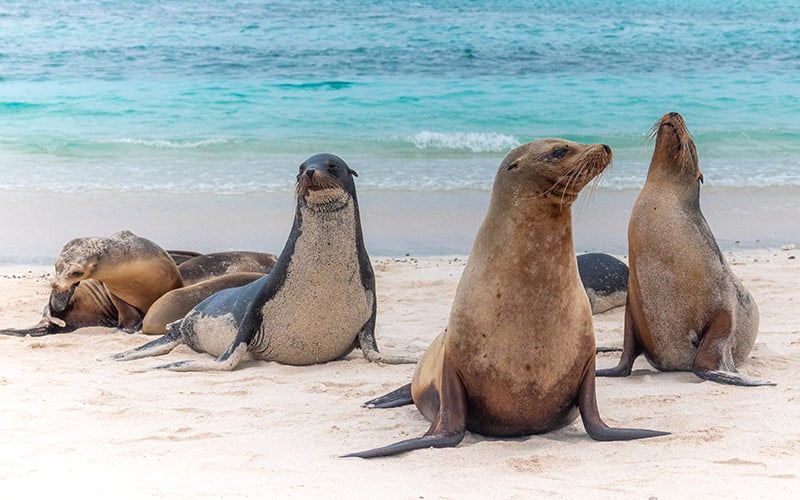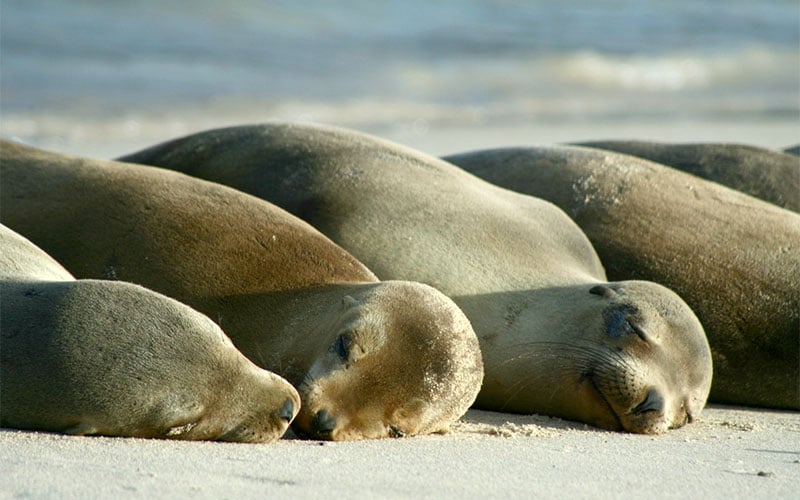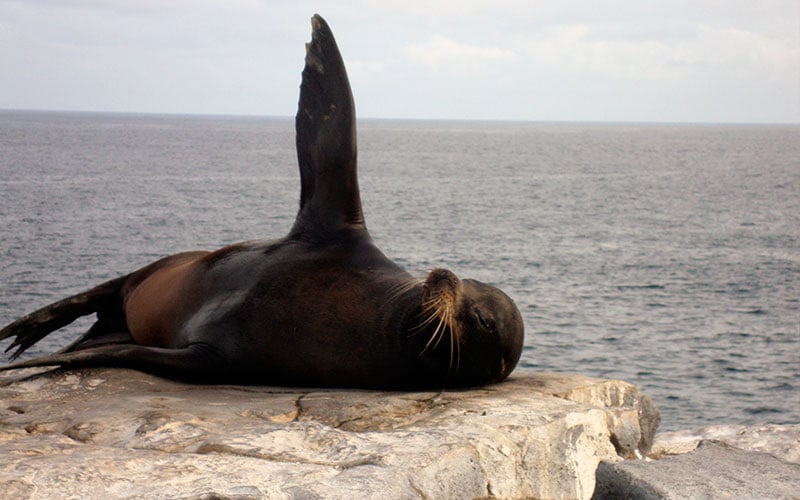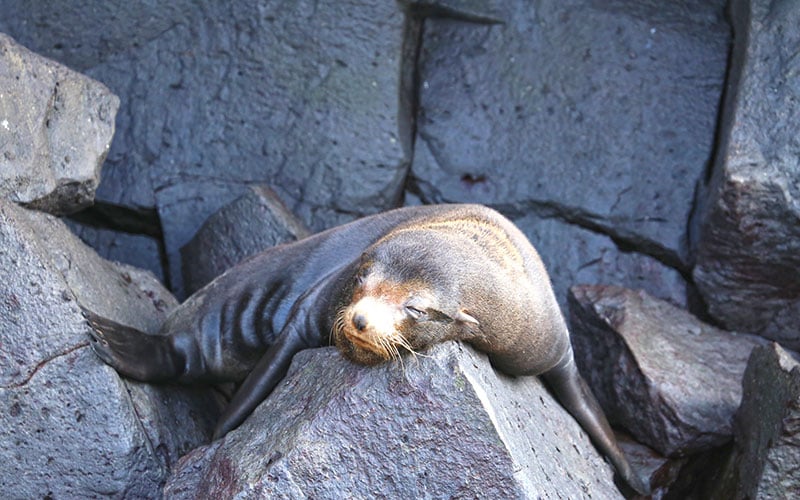Of all the sea animals perhaps sea lions are the most playful and the Galapagos Sea Lion is no exception. If you wanted to throw an imaginary animal party then sea lions would be close to top of your guest list; they are just so much fun!
Of all the animals that create a Galapagos memory mosaic for visitors often the Galapagos Sea Lion will paint the most vivid memories. Being unafraid of us and naturally curious they’ll approach you first underwater and are totally accepting of your presence on land.
Sea lions, or sea wolves as they are called in Spanish, belong to the same family as seals and walruses. Galapagos Sea Lions are one of just six types of sea lions. They were thought to be Californian Sea Lions until recently but the latest DNA research confirmed them as a distinct species that separated from the California Sea Lion about 2 million years ago. They are smaller, have shorter muzzles and smaller forehead ridges than their Californian cousins – and don’t forget, just like most Ecuadorians … they are really friendly!
Many Galapagos cruises involve landing at beaches and chances are you will encounter sea lions right there on the beach as they have to be the ultimate beach bums in the Galapagos. But most likely, even before you see them on a beach, you will see them in the port of Puerto Ayora, where some Galapagos Sea Lions will take their afternoon siestas on a bench rather than the beach.
A question that has always intrigued scientists is exactly why mammals like to play with each other. Normally we think that it helps with adult activities like hunting or fighting each other but the reality is that scientists have had a heck of a job trying to prove that theory.
In fact, when they have effectively set up experiments with rats and controls, they haven’t found any significant advantage for those who partied hard. The only interesting conclusion from years of studies is that playing a lot and having fun leads to larger brains. Ha! Isn’t this the conclusion that gamer teenagers around the world want to hear?
So what hope of understanding why sea lions are so playful? For now, it’s OK to just to be with Galapagos Sea Lions and let them play with us, drawing us into their fantasy world of mischief and acrobatics.

So where are the best places to see them? They can be found on every island in the Galapagos archipelago but they tend to hang out more in certain spots such as Bartolome, Sombrero Chino, Rabida, San Cristobal, Isla Lobos, Gardner Bay, Punta Suarez, Islas Plaza, North Seymour, Punta Vicente Roca, Punta Espinosa and they can be found all year round but perhaps the best time to see them is between July and November when there are many sea lion pups in nurseries being protected by their watchful mothers.
Breeding takes place from May to January and during this time you can see fights between bull Galapagos Sea Lions weighing up to 300 pounds. They fight for dominance of between 5 and 25 females, the ‘harem’, and it’s a winner take all scenario leading to many bachelor parties as all the vanquished bulls tend to live together but apart.
The dominant bull then ferociously guards his shoreline territory against all challengers and there are so many that he typically has little time to eat between mating and fighting off challenges by other males. This aggressiveness has not gone unnoticed by filmmakers at Disney who in their animated 2016 film ‘Finding Dory” had 2 sea lion characters called Fluke and Rudder sat on a rock in a harbor and when another sea lion called Gerald approaches to get on the rock they go berserk repeatedly yelling “Off off, off” at the poor unfortunate Gerald.
For the dominant bulls, their time as ‘king of the pack’ normally doesn’t last more than a month as they actually lose weight rapidly and become weak due to starving themselves defending and entertaining their harem.
Sea lions are carnivores and great hunters and really in their element in the water. There are untold accounts of their acrobatic antics underwater. One diver said that her experiences in the Galapagos waters with sea lions were so incredible that even “armies of hammerhead sharks could not compete” and she isn’t alone as dozens of enthusiastic divers describe the sea lions doing corkscrew turns, jutting their faces into your mask, circling and racing off only to return an instant later.

All this incredible agility serves them well – even if we can’t prove it – because they are adept fishers catching sardines, small squid and even tuna from the nutrient-rich waters. In 2013 scientists observing an adult female Galapagos Sea Lion tracked her dive down to a depth of 1,900 feet lasting ten minutes. I’m not quite sure what she was chasing down there but I hope it was worth it!
On the other hand, maybe she was being chased. Orcas and sharks are the natural predators of Galapagos Sea lions but that isn’t a totally one-way relationship as close to the shoreline adults and even pups have been seen to mob a lone shark driving it away.
Sadly, perhaps the biggest danger to Galapagos Sea Lions comes from global warming which seems set to increase. Warm seas mean less food in the Galapagos and so breeding is disrupted. Warm waters also see increased numbers of a deadly parasite that infects the eyes of baby Galapagos Sea Lions to such an extent that in one study done in 2015 only 21 of 91 pups survived meaning this species of sea lion will have a tough time recovering from its current ‘endangered’ status.,
And while some people are still not convinced about the existence of Global warming there can be no denying that contamination of the oceans with plastic containers is a man-made problem and unfortunately sea lions and other marine animals that swallow plastic don’t fare well often dying.
We live in a rapidly changing world and for now, at least you can share a snooze with a Galapagos Sea Lion on a bench, lounge around on a beach with them, blow bubbles at sea lion pups when diving or just admire a feline show when snorkeling in the shallows. No need to seek them out, they’ll

Galapagos Sea Lions Move to Peru
A colony of Galapagos sea lions has moved to Peru – and scientists blame global warming. The Galapagos Islands are home to many endemic species, including the Galapagos Sea Lion, found nowhere else in the world. The lovable Galapagos sea lion is a favorite among Galapagos visitors, delighting travelers with their antics and underwater acrobatics.
In the past, an occasional individual Galapagos Sea Lion would swim too far out to sea, get caught in a current and find itself along the coast of Peru, Ecuador or even Colombia, but those were cases of unfortunate individuals. In this case, an entire colony of some 30 Galapagos Sea Lions has taken up residence off the coast of Peru on Foca Island. Foca Island is already home to wildlife including sea lions and Humboldt Penguins. The Galapagos Sea Lions will also recognize old friends such as Blue-footed Boobys and Frigate Birds in their new home.
According to scientists, the move is not completely unexpected. Global warming has been wreaking havoc on local ecosystems for years. Peruvian scientists estimate that the average water temperature off of Foca Island has gone up from 17° to 23° Celsius in the last decade or so. This warmer water is attractive to the Galapagos sea lions, accustomed to a warmer environment. The increased temperatures are also affecting the Galapagos Islands, where many species are in peril and some are thought to have gone extinct.
The traveling sea lions aren’t the first ones to leave the Galapagos Islands to take up residence elsewhere. A Galapagos tortoise named Harriet, who was taken from the islands while very little, lived for decades in the Australia Zoo, where she was a visitor favorite. She passed away in 2006, at the age of 175 years old! Another Galapagos giant tortoise named Diego was acquired by the San Diego zoo in the 1930’s, although he was sent back to the islands in 1977 and is now a neighbor of Lonesome George at the Charles Darwin Research Station in Puerto Ayora.

